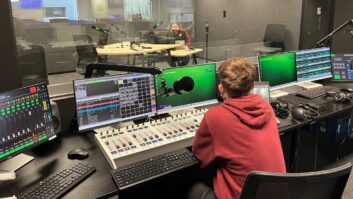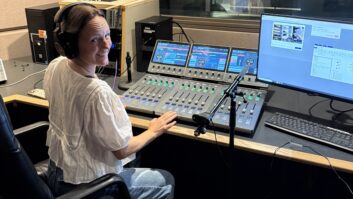SEATTLE On Jan. 1, 2002, KKOL(AM), 1300 kHz, began broadcasting from temporary facilities installed aboard the 175-foot cargo ship, the Coastal Ranger, in Seattle’s Elliott Bay.
The 1,000-watt transmitter facility is the only licensed broadcast station operating in the United States aboard a ship. A Valcom 74-foot fiberglass whip antenna installed on the deck of this steel-hulled ship moored in seawater is providing temporary coverage for the Seattle area while the station’s new 50 kW transmitter facility is completed.
A temporary site?
In the spring of 2001, Salem Broadcasting, owners of KKOL, agreed to abandon the historic landmark transmitter facility on Seattle’s Harbor Island so the Port of Seattle could expand its cargo container handling facilities. Salem is replacing the old facility with a new 50 kW, four-tower facility on a new site south of downtown Seattle.
I was asked to implement a temporary transmitter facility to prevent the station from going dark while the new facility was being constructed. The temporary facility would operate under FCC rules for Special Temporary Authorization. My goal was to preserve as much of the original licensed coverage area as possible while complying with STA rules.
Two traditional temporary solutions were explored: a long wire attached to a tall structure, such as a smoke stack or existing tower structure, or sharing an existing broadcast antenna. Several tall structures were evaluated but were not suitable. An existing broadcast antenna was located a mile from the old facility, but was already shared by two stations, and one of the frequencies was too close to 1300 for triplexing. FCC rules and local zoning regulations prohibited erecting a conventional antenna, even a short, temporary one.
The process
Several years ago, I met Paul MacPherson of Valcom Antennas at Valcom’s booth at NAB in Las Vegas, and was introduced to his center-loaded fiberglass whip, which has been used for years for maritime installations and had been scaled for broadcast use. With this antenna in mind, I concluded the Valcom antenna could be mounted on a steel-hulled boat and moored in the salt water of Puget Sound for a temporary transmitter facility.
I located a 175-foot cargo ship, the Coastal Ranger. The ship was one of several that would deliver supplies to Alaskan fishing companies in Dutch Harbor in the Aleutian Islands and then would return to Seattle with a cargo of frozen fish. The boat was retired from active service and was moored near Fisherman’s Terminal in Seattle’s Ballard area.
A 74-foot Valcom antenna was ordered and tuned for 1300 kHz operation and shipped to the Ballard location along with a new Broadcast Electronics 2.5 kW transmitter.
A Valcom steel hinge plate was welded onto the aft deck over an area with substantial reinforcement below the deck. The antenna was attached to the base plate and then raised vertically using a truck-mounted boom crane.
A steel 20-foot cargo shipping container was secured to the aft deck near the antenna. The double doors at the end of the container were replaced with a wood wall with a door and a ventilating fan installed. The BE transmitter was installed in the container along with a rack with monitoring and remote-control equipment. The ATU was installed inside the container with a feed for the antenna connection.
The ship was moved from Ballard to its new home near the old transmitter site on Harbor Island in Elliott Bay. The new “maritime” facility was turned on Jan. 1, 2002, and has been operating continuously since.
The results
Because the antenna platform on the boat remains at the same level relative to the waters surface, little or no variation in base current or field strength has been observed, even at the extremes of 16-foot tidal swings. The boat is moored in a relatively sheltered area, so wind and wave action has had no detrimental effect on the signal.
The facility performance is outstanding. The signal from the STA site has been consistent and reliable and covers a significant percentage of the original licensed coverage area. Several sets of field measurements have confirmed good coverage and excellent efficiency.
This effective solution to a difficult problem would not have been possible without the innovative Valcom fiberglass whip antenna. The Valcom antenna is well designed, easy to erect and maintenance-free. Field measurements indicate this loaded 74-foot whip is performing similar to a traditional quarter-wave vertical antenna.
For more information, including pricing, contact the company in Virginia at (540) 563-2000 or visit www.valcom.com







